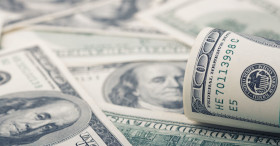The US dollar is trading relatively flat against its currency competitors on Thursday as retail sales surged in June but weekly jobless claims disappointed. With Europe choosing to pause on expanding its relief and stimulus measures, the broader global financial market has been subdued, providing little momentum for the greenback.
According to the Department of Labor, initial jobless claims came in at 1.3 million for the week ending July 11, worse than the median estimate of 1.25 million. This is down slightly from the previous weekâs reading of 1.31 million. Continuing jobless claims topped 17.338 million, while the four-week average, which eliminates week-to-week volatility, reached 1.375 million.
Overall, the number of Americans filing for first-time unemployment benefits is at its lowest level in more than four months.
Last month, retail sales advanced 7.5%, beating market forecasts of 5%, the US Census Bureau reported on Thursday. In May, retail sales skyrocketed at an all-time high of 18.2%. The biggest gains were seen in apparel (105.1%), electronics and appliances (37.4%), furniture (32.5%), food and drink (20%), and gasoline stations (15.3%). There were modest drops for non-store retailers (-2.4%) and building material and garden equipment (-0.3%). Retail sales went up 1.1% at an annualized rate in June.
In a separate report, the Census Bureau reported that manufacturersâ business inventories fell 2.3% in May, down from a 1.4% slump in April. This was the steepest decline in business inventories on record as stocks fell at retailers (-6.2%) and wholesalers (-1.2%). Year-on-year, business inventories slipped 4.8%.
The National Association of Home Builders (NAHB) housing market index soared 14 points to 72 in July, topping market expectations of 60. This is the best reading since March. This came one day after the Mortgage Bankers Association (MBA) found that mortgage applications increased 5.1% in the week ending July 10.
On Wednesday, industrial production rose 5.4% in June, while manufacturing output advanced 7.2%. Import prices jumped 1.4% last month, while export prices increased by 1.4%. Capacity utilization edged up more than 3% to 68.6%.
The US Dollar Index, which measures the greenback against a basket of currencies, slumped 0.16% to 95.93, from an opening of 96.00. The index is on track for a weekly loss of 0.8%, bringing its year-to-date loss to 0.47%.
The buck could little momentum in global financial markets after the European Central Bank (ECB) left its key interest rates and quantitative easing program unchanged at its July policy meeting.
The USD/CAD currency pair rose 0.03% to 1.3515, from an opening of 1.3510, at 14:39 GMT on Thursday. The EUR/USD picked up 0.06% to 1.1442, from an opening of 1.432.
If you have any questions, comments, or opinions regarding the US Dollar, feel free to post them using the commentary form below.
US Dollar Flat As Retail Sales Surge, Jobless Claims Disappoint
